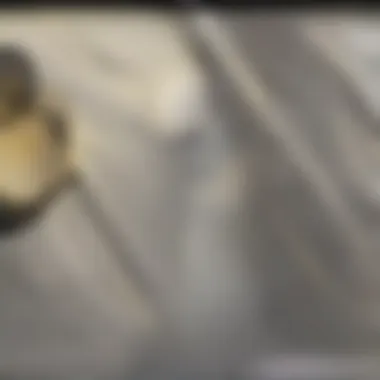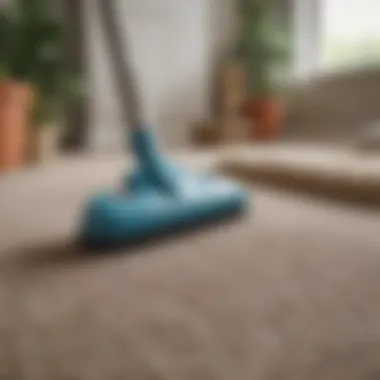Best Ways to Clean Your Area Rug by Hand Efficiently


Intro
Maintaining the beauty and durability of area rugs requires a dedicated approach. Cleaning rugs by hand, while time-consuming, offers a unique connection to the material and emphasizes the details of the fabric that machine cleaning may overlook. Careful attention to cleaning not only preserves the aesthetic of your home but also extends the life of these pieces, making them worthwhile investments. This guide serves as a thorough resource for anyone keen on enhancing their area rugs through proper cleaning methods.
Importance of Hand Cleaning
Cleaning area rugs by hand is essential for several reasons. Firstly, many rugs, especially those made from delicate materials like silk or wool, require gentler methods that are often unsuitable for machines. Secondly, hand cleaning allows homeowners to pay attention to specific stains or problem areas, ensuring no spot is left untreated. Lastly, this process fosters a better understanding of the materials and construction of the rugs, ultimately contributing to informed care decisions.
"A well-maintained rug can transform a space, enhancing its warmth and character."
Overview of Techniques
This article will explore various techniques tailored to different types of rugs. Readers will discover the necessary tools and materials vital for effective cleaning. It will also address preventative care measures essential in maintaining rug longevity. By the end, participants will feel empowered to tackle rug cleaning with confidence, ensuring their investments remain in excellent condition for years to come.
Target Audience
This guide is particularly beneficial for real estate enthusiasts, travel lovers, and interior design aficionados, allowing them to understand the nuances of rug care and how it contributes to their overall interior decor.
Finale
Cleaning area rugs by hand is an art that combines care, knowledge, and technique. With the right methods, anyone can maintain their rugs' beauty and durability, enriching their living spaces in the process.
Intro to Area Rug Maintenance
Maintaining area rugs is a crucial aspect of home care. These decorative pieces can enhance the overall appeal of a living space. They provide warmth, comfort, and often an artistic touch. However, their beauty can quickly diminish if not properly cared for. Understanding how to clean and maintain area rugs is essential for preserving their appearance and durability.
Cleaning rugs properly can prolong their lifespan. It helps in preventing allergens and dust mites from accumulating, which can affect indoor air quality. Yet, many homeowners overlook regular cleaning due to uncertainty about methods or a belief that professional cleaning is too costly or inconvenient.
Hand cleaning offers an accessible and reliable solution. This method allows individuals to tailor their cleaning to the specific needs of the rug, whether it is wool, synthetic, or delicate silk. Moreover, it gives one the satisfaction of knowing that their cherished decor is being treated with care. In this context, understanding the methods and best practices for hand cleaning is invaluable.
Understanding the Importance of Rug Cleaning
Regular rug cleaning is vital for several reasons. Firstly, dirt and dust accumulate over time, embedding themselves into the fibers. This can lead to discoloration and fading, especially in vibrant patterns. The more frequently a rug is cleaned, the better it will retain its original luster.
Additionally, rugs can harbor allergens and bacteria. Particularly in households with pets or children, the potential for spills and stains increases. Regular cleaning mitigates the risk of these particles deteriorating not just the fabric, but also the health of the home environment.
"A well-maintained rug not only beautifies a room but contributes significantly to the overall hygiene of a living space."
Another essential factor is the aesthetic value. Clean rugs make spaces appear more inviting. They reflect the care taken in maintaining one's home. When visitors come, they often notice the little details, and a clean rug can leave a positive impression.
The Role of Hand Cleaning in Rug Care
Hand cleaning plays a significant role in maintaining area rugs because it allows for a careful and personalized approach. Unlike machines, which might be too aggressive or indiscriminate, hand cleaning can cater to the uniqueness of each rug. It enables individuals to pay attention to specific areas that may require extra care, thus avoiding potential damage.
In addition, hand cleaning promotes a deeper connection with one’s decor. The act of cleaning can be meditative, allowing homeowners to appreciate the textures and colors of their rugs more closely. This process fosters a greater understanding of the rug's materials and their needs.
Moreover, hand cleaning can be more effective in addressing particular problems, such as stains and odors. Identifying the right cleaning solution and technique can be as simple as experimenting during the cleaning process, ultimately ensuring that each rug receives the tailored attention it deserves.
Types of Area Rugs and Their Cleaning Needs


Cleaning area rugs is not a one-size-fits-all endeavor. The type of material and construction of a rug significantly affects how it should be cleaned. Understanding these differences is essential for maintaining the aesthetic and longevity of your rugs. Each type has unique characteristics that draw in dust, dirt, and stains, and the cleaning methods must align with these properties. In this section, we will examine various rug types and their specific cleaning requirements.
Wool Rugs
Wool rugs are celebrated for their warmth and durability. They often require specialized care due to their natural fibers. The main benefit of wool is that it naturally repels dirt and moisture. Regular vacuuming can keep them looking fresh. However, when stains occur, prompt action is necessary.
For everyday cleaning, avoid excessive water, as too much can cause damage. Instead, use a damp cloth with a suitable cleaning solution. It's best to test any solution on an inconspicuous area first. Once cleaned, allow the rug to dry completely, and avoid direct sunlight to prevent fading.
Synthetic Rugs
Synthetic rugs, such as those made from nylon or polyester, offer versatility and resistance to stains. They are generally easier to clean than natural fiber rugs. The ability to use a wider range of cleaning products is a significant advantage. Stains can often be treated with mild soapy water or commercial carpet cleaners.
These rugs can tolerate more moisture, making them suitable for various cleaning techniques, including machine washing in some cases. However, it is still vital to follow instructions on the label to prevent damage. Regular vacuuming helps maintain their appearance over time.
Silk and Delicate Rugs
Silk rugs, while luxurious, are prone to staining and damage. They require the utmost care during cleaning. Because silk is a delicate material, using water is risky as it can cause the fibers to weaken or the colors to bleed.
For cleaning, use a soft brush or dry foam cleaning method instead of soaking the rug. Blot any spills immediately with a dry cloth rather than rubbing, which can spread the stain. To maintain their quality, consider professional cleaning periodically. This ensures the silk stays vibrant without risking damage from improper cleaning methods.
Natural Fiber Rugs
Natural fiber rugs, made from materials like jute or sisal, are durable but can absorb stains and odors. Cleaning these types requires a delicate approach. Vacuuming regularly helps eliminate dust and debris, but moisture should be used sparingly. Spillages should be dealt with instantly by blotting dry with cloth.
Mixing a small amount of vinegar with water can help with odor removal, applied with a cloth and dried thoroughly after. Natural fiber rugs can be sensitive to water damage, so avoiding full immersion in water is crucial. For deep cleaning, professional assistance may be needed to preserve their structural integrity.
In sum, recognizing the nuances of each rug type empowers you to adopt the best cleaning practices. Tailoring your approach according to the rug material not only prolongs its lifespan but also enhances its beauty.
Preparatory Steps Before Cleaning
Before embarking on the task of cleaning an area rug, proper preparation is essential. This foundational stage ensures a smooth cleaning process, minimizes potential damage, and enhances the effectiveness of the cleaning techniques applied. Understanding the nuances of this preparatory phase can greatly impact the results of your efforts.
Assessing the Rug's Condition
Assessing the rug's condition is the first critical step in the cleaning process. This involves closely inspecting your rug for any visible damage, such as frayed edges, discoloration, or stains. Furthermore, notable factors include checking the fabric type and its age, which can indicate how delicate or robust the rug may be. A well-considered assessment allows one to tailor the cleaning approach specifically to the rug's needs, thus preventing mishandling that could lead to further wear.
Gathering Necessary Supplies
Gathering the necessary supplies forms another vital part of the preparatory steps. Having the appropriate tools not only streamlines the process but also enhances cleaning effectiveness. Below are specific items that should be collected:
Vacuum Cleaner
A vacuum cleaner plays a pivotal role in the initial cleaning phase. Its primary contribution lies in removing loose dirt and debris from the rug. A vacuum with a gentle suction option or one equipped with a beater bar can effectively lift dirt without damaging the fibers. A beneficial feature to look for in a vacuum cleaner is the attachment tools, which allow for more precise cleaning on edges or in high-pile areas. However, the downside may include limitations when dealing with deeply embedded dust in thicker rugs, which may require additional cleaning techniques.
Soft Brush
A soft brush can be very useful when performing a deep clean. It helps in loosening dirt that is trapped within the fibers. The key characteristic of a soft brush is that it does not damage the rug’s threads, making it a popular choice for delicate fabrics. A unique feature to note is its ability to reach areas that vacuums may miss, like corners. An associated challenge might be the time it requires to manually brush larger rugs.
Cleaning Solutions
Cleaning solutions can vary widely, each serving different rug materials. The importance of selecting the right solution cannot be overstated. A suitable cleaning solution will both clean effectively and preserve the rug's fibers. Look for solutions that are specially formulated for area rugs. Their unique feature often includes being eco-friendly, which makes them a favored choice among conscientious consumers. However, certain cleaning solutions might have chemical components that could harm sensitive rugs, so careful selection is paramount.


Soft Cloths
Soft cloths are necessary for tackling stains and spills during the cleaning process. Their lightweight nature makes them easy to handle, and they help to absorb any moisture without leaving scratches. A standout characteristic of soft cloths is their versatility; they can also be used for delicate drying or for applying cleaning solutions without risk of damage. A limitation exists in their capacity for heavy-duty stain removal, as they might not be sufficient for tougher, ingrained stains.
Finding a Suitable Cleaning Space
Selecting a suitable cleaning space completes the preparatory steps. This space should ideally be well-lit and spacious enough to accommodate the entire rug. Ensuring a clean area can also prevent dirt from reinvesting in the freshly cleaned rug. Potential options could include a patio or a large laundry room. The convenience of selecting the right spot can contribute to a more efficient cleaning process, minimizing distractions and allowing for focused attention on the task.
Step-by-Step Manual Cleaning Process
Cleaning an area rug manually is a powerful approach that allows for personalized care. By following a systematic process, you can ensure that the rug receives the attention it needs, enhancing its longevity and appearance. Manual cleaning is essential for tackling stubborn dirt and stains that regular vacuuming cannot remove. It gives you more control over the cleaning solutions and techniques used, which is crucial for maintaining the integrity of various rug types. Additionally, manual cleaning tends to be gentler, minimizing the risk of damage that can occur with machine cleaning.
Vacuuming the Rug
Vacuuming is the first step in the manual cleaning process. It works to remove loose dirt, dust, and debris that accumulate over time. The importance of this step cannot be overstated; it prepares the rug for deeper cleaning and helps prevent dirt from settling into the fibers. When the rug is vacuumed thoroughly, it becomes easier to identify stains for further treatment. Notably, ensure you vacuum in multiple directions. This technique helps lift dirt trapped in the fibers more effectively.
Spot Cleaning Stains
Spot cleaning is crucial for addressing specific stains that can tarnish the appearance of your rug. Ignoring stains can lead to permanent discoloration, making this a pivotal part of your cleaning process.
Identifying the Stain Type
Understanding the stain type is the first step toward successful spot cleaning. Different stains, such as food, wine, or pet urine, require different cleaning methods. The key characteristic of identifying the stain type is that it dictates the cleaning solution to be used. For instance, protein-based stains need enzymes for effective removal, while dye stains may require a color-safe bleach. By accurately identifying the stain type, you can choose the best approach. This knowledge contributes significantly to maintaining the rug's overall aesthetics.
Applying Appropriate Cleaning Solutions
After identifying the stain, choosing the right cleaning solution is crucial. The correct cleaning solution ensures effective stain removal without damaging the fibers. A popular choice for spot cleaning in this article is using a solution that is specifically formulated for the type of stain identified. Common household solutions include white vinegar for fresh stains or a mild detergent for grease. Each cleaning product has unique features; for example, enzyme cleaners break down organic matter, while vinegar neutralizes odors. However, be cautious; over-applying solutions can lead to residue build-up.
Deep Cleaning Techniques
Deep cleaning is an essential element of manual rug care. It addresses any deep-seated dirt and revives colors in the fibers.
Using a Soft Brush
Using a soft brush is fundamental to the deep cleaning process. It allows for gentle agitation of the fibers without causing damage. The key characteristic here is that it lifts dirt without fraying or pulling at the fibers. A soft brush is beneficial because it can reach into the crevices of the rug, where vacuuming might not suffice. However, one must be careful not to apply too much pressure, as it could lead to fiber distortion or snags.
Rinsing and Drying the Rug
Rinsing is the final step in the deep cleaning process. This stage helps remove any remaining cleaning solution and dirt, preventing residue build-up. The key characteristic of rinsing is that it ensures the rug is free of any cleaning agents before drying. This is important to maintain the rug's integrity and prevent future staining. After rinsing, it is necessary to dry the rug thoroughly to prevent mold growth and maintain odor-free condition. The unique feature here involves air drying the rug in a well-ventilated area while avoiding direct sunlight, which could cause fading.
"Understanding the manual cleaning process is essential for any area rug owner. Each step contributes to the longevity and beauty of your rugs."
Overall, each of these processes plays a vital role in maintaining the health of your area rug. By following these methods, you not only improve the rug's appearance but also extend its lifespan.
Post-Cleaning Care for Area Rugs
Post-cleaning care for area rugs is crucial to ensure their longevity and maintain their aesthetic appeal. After putting in the effort to clean your rug by hand, neglecting the right post-cleaning procedures can adversely affect its condition, leading to wear and potential damage.
By focusing on proper drying techniques and careful repositioning, you can protect your investment and keep your area rugs looking their best.


Proper Drying Techniques
Drying an area rug properly is a vital step post-cleaning. Water can be damaging to the fibers if not handled correctly, leading to mildew or mold growth and potential staining. Here are key techniques to dry your rug effectively:
- Air Drying: Always opt for air drying as the preferred method. Lay the rug flat in a well-ventilated area away from direct sunlight, which can cause colors to fade.
- Use Fans: To expedite the drying process, you can use fans. Place them around the rug to facilitate airflow. This will help in evaporating moisture without applying excessive heat.
- Avoid Heat Sources: It is essential to keep the rug away from heaters or radiators, as excess heat can cause fibers to shrink and warp.
Pay attention to the underside of the rug. It’s essential that this area is also dry to prevent dampness and odors.
Repositioning the Rug
Once your area rug is dry, repositioning is the next critical step. Proper repositioning ensures that the rug remains flat and prevents it from bunching or curling, which can create safety hazards.
- Choose the Right Location: Ensure the rug is placed in a suitable area of the room, ideally on a level surface. Avoid placing it in high-traffic zones immediately after cleaning.
- Use Non-Slip Pads: To enhance stability, consider adding non-slip rug pads. These pads will keep the rug in place and are particularly useful for preventing slips on hardwood or tile flooring.
- Allow Time: Give the rug some time to settle in its new position. This will help maintain its shape and appearance while preventing any uneven wear.
"Proper post-cleaning care can significantly extend the life of your area rug, preserving both its functionality and beauty."
By diligently following these post-cleaning care practices, you ensure that your area rug enhances your living space effectively for years to come. Regular attention to these details will yield lasting benefits, keeping your rugs vibrant and inviting.
Preventative Measures for Long-Term Care
Maintaining the aesthetic and functional qualities of area rugs is essential for their longevity. Preventative measures play a vital role in preserving rugs, enhancing their utility and appeal. By taking proactive steps, owners can avoid the accumulation of dirt, stains, and wear, which often lead to extensive cleaning efforts or even replacement. A well-thought-out preventative care strategy not only extends the life of the rug but also minimizes the frequency of manual cleaning.
Regular Vacuuming Schedule
Creating and adhering to a regular vacuuming schedule is crucial for the upkeep of area rugs. Vacuuming helps remove dust, dirt, and allergens that can settle into the fibers. It is advisable to vacuum rugs at least once a week, or more often in high-traffic areas. For rugs made from delicate materials such as silk, a gentle vacuum setting or using a hand-held vacuum avoids damage.
Additionally, pay attention to the edges and corners during vacuuming. These areas often collect debris. A consistent schedule ensures that dirt does not have a chance to embed into the fibers, thus preserving the rug's aesthetics and softness.
Protective Treatments
Applying protective treatments to rugs can enhance their durability. Many products are available that offer a barrier against spills and stains. These treatments typically repel liquids, making it harder for stains to set. When purchasing a protective spray, ensure it is suitable for your rug's material.
Keep in mind that protective treatments often require reapplication every 6 to 12 months, depending on the type of treatment and the rugs' exposure to wear. Such maintenance efforts can save time and money in the long run by reducing the need for intensive cleaning.
Avoiding Direct Sunlight
Direct sunlight can lead to color fading and damage to area rugs. To minimize this effect, place rugs away from windows or use window treatments to limit sun exposure. If repositioning the rug is not feasible, consider rotating the rug periodically. This practice ensures even wear and fading across the entire surface.
Additionally, UV-blocking films can be applied to windows, which will help protect rugs from harmful rays. Taking these precautionary steps will help maintain the vibrancy and integrity of the rug, keeping it looking its best for years.
The End
Cleaning area rugs by hand is fundamental for maintaining their beauty and longevity. Regular cleaning not only restores the vibrant appearance of rugs but also extends their life. For homeowners, understanding the specific needs of their rugs, from wool to silk, plays a crucial role in effective maintenance.
Summarizing Key Cleaning Takeaways
Here are some important points to consider when cleaning your area rug by hand:
- Identify the Material: Different types of rugs require distinct cleaning methods. For example, wool rugs can handle moisture, while silk rugs need a much more delicate touch.
- Use Proper Techniques: Always start with vacuuming to remove loose dirt. Spot cleaning stains promptly with the right cleaning solutions is vital for removing blemishes without harming the fabric.
- Deep Cleaning: For a thorough cleaning, techniques like soft brushing and careful rinsing methods will help retain the rug's texture and appearance.
- Drying and Care: After cleaning, proper drying is essential to avoid mold and odor. Placing the rug in a well-ventilated area is ideal.
Encouraging Regular Maintenance
Routine maintenance can significantly enhance the lifespan of your area rugs. Here are some key practices:
- Create a Vacuum Schedule: Regular vacuuming helps in removing dust and dirt, preventing buildup. It is recommended to vacuum weekly for high-traffic areas.
- Utilize Protective Treatments: Consider applying treatments that can help repel stains and reduce wear. This allows for easier cleaning in the long run.
- Avoid Excessive Sunlight: Position your rugs away from direct sunlight to prevent fading. Rotating your rugs can also help expose all areas equally to light, preventing uneven wear.
By incorporating these methods into your routine, you ensure that your area rugs remain in top condition, contributing to the overall aesthetic of your space.















